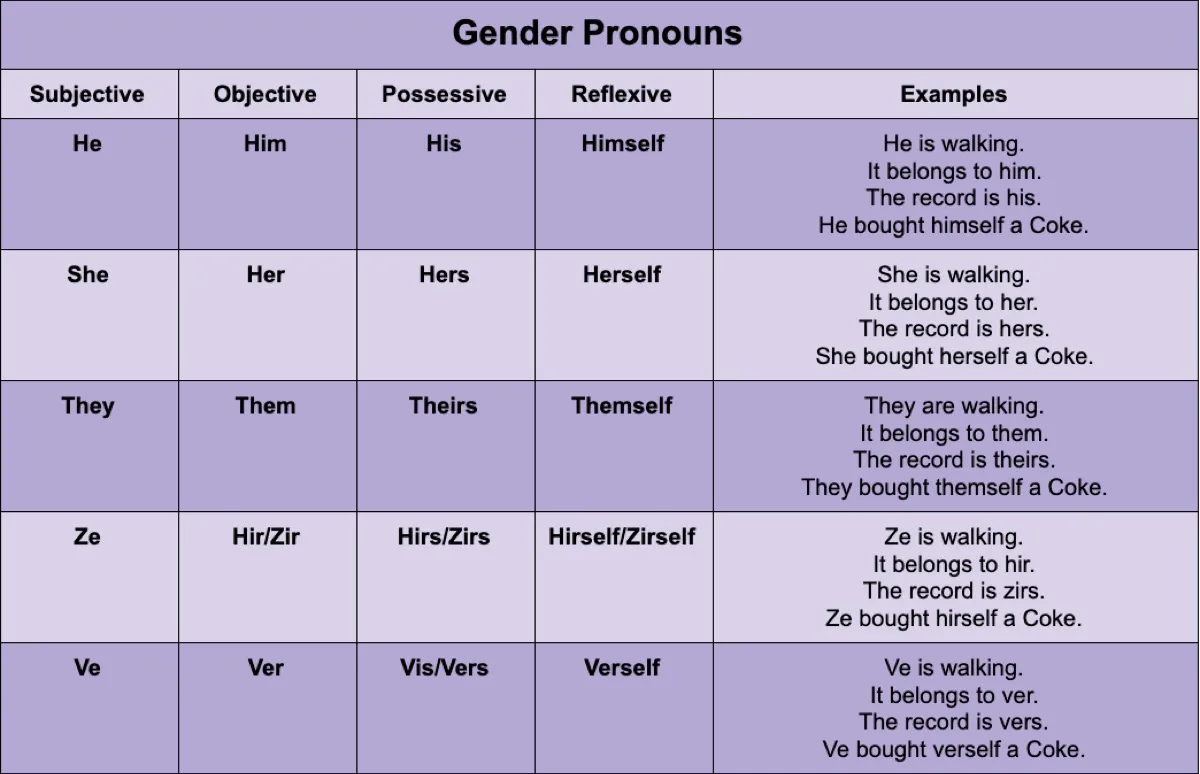Your Guide to Gender Pronouns

Now more than ever, people aren’t necessarily identifying with the sex they were assigned to at birth. Some people are transgender, meaning they identify as a different gender than the sex they were assigned. But others refer to themselves as non-binary, meaning they don’t identify as exclusively male nor exclusively female. And while most of us try our best to respect these gender non-conforming individuals, sometimes language—and a simple lack of information—can make that complicated.
That said, it’s pivotal to take note when someone tells you which pronouns they prefer. As Sassafras Lowrey, a genderqueer author, explained on the HuffPost, “When someone says my pronouns are ‘too hard’ for them to remember, what I hear is that you don’t value our friendship, the work that I’m doing in the world, or me as a person.”
While males and females tend to use the pronouns we’re all familiar with to describe themselves—he/him and she/her—some non-binary individuals choose different pronouns that you may not have heard of before.
Since gender-neutral pronouns can be a bit confusing, we’ve come up with a comprehensive guide (and chart!) to help you understand them, just in time for Pride Month.
What are gender pronouns?
A gender pronoun is “the pronoun that a person chooses to use for themselves” to describe their gender, according to New York City’s Department of Social Services. What this means is that, even if a person was born with female genitalia, they may still elect to use masculine pronouns to describe themselves, depending on what suits their gender expression.
For transgender people, a change of pronouns can help them identify more closely with the gender they are inside.
And recently, more and more people have begun adopting gender-neutral pronouns—those that neither connote male nor female gender. These people feel as though the typical male and female pronouns do not accurately represent their gender identities and expressions.
Those who identify as non-binary or gender non-conforming choose whichever pronouns suit them. According to the University of Wisconsin-Madison’s LGBT Campus Center, they often opt to use gender-neutral pronouns like “ze/zir/zirself” and “ve/ver/verself.”
Though it can be confusing, some non-binary people choose the pronouns “they” and “them” in place of “he/him” or “she/her,” since there is no gender associated with “they/them.” As you’ll see in the chart below, these pronouns mostly take on plural verbs—as in, “they are walking”—but refer to a singular person. In the reflexive, however, “they” is used singularly (i.e. “themself”).
What are the different gender (and gender-neutral) pronouns?

In addition to the gender-neutral pronouns listed in the above chart (they, ze, and ve), a couple other common gender-neutral pronouns include xe/xem/xyr/xyrs/xemself and per/pers/perself.
Non-binary individuals also sometimes elect to replace pronouns with their name and then use the third person. For many gender-confirming individuals, this simple change can be easier to get the hang of.
How do you use gender pronouns?
According to the University of Wisconsin, Milwaukee’s LGBT Resource Center, it’s important to first ask someone which pronouns they use to identify themselves. You can’t—and shouldn’t—judge a book by its cover. Simply asking, “What are your gender pronouns?” can be one of the easiest ways to show support for the LGBTQIA+ community, as it signals to them that you both care about and respect them. We all should be able to use pronouns that accurately describe our gender identity and expression.
So, for those of you who want to be allies to the LGBTQIA+ community, start familiarizing yourself with the pronouns of friends, family members, and strangers. The small act of using a person’s proper pronoun can make all the difference in their day. And for more ways to make the world a better place, here are 33 Little Acts of Kindness You Can Do That Are Totally Free.
To discover more amazing secrets about living your best life, click here to follow us on Instagram!